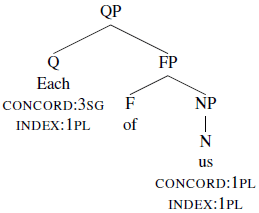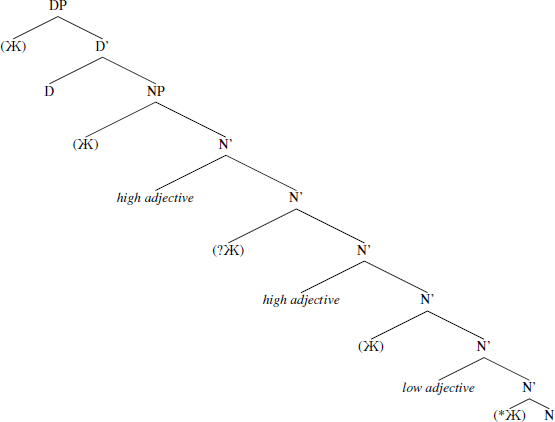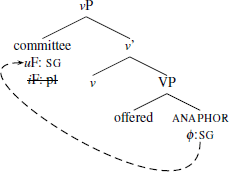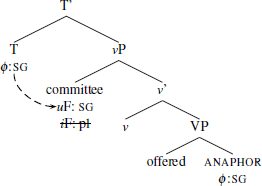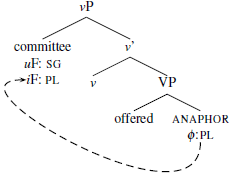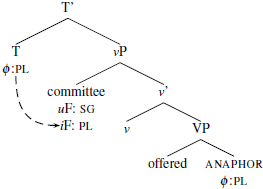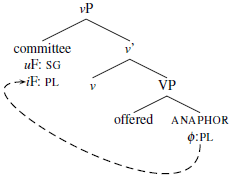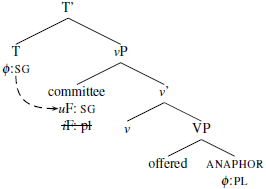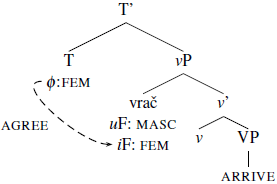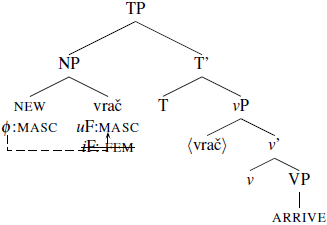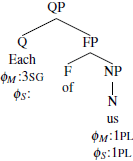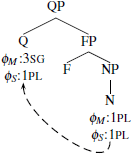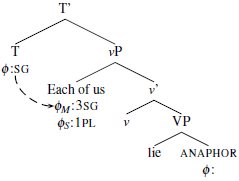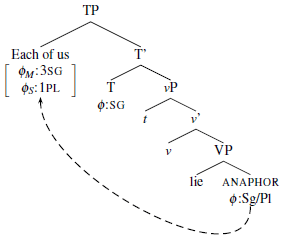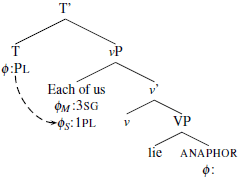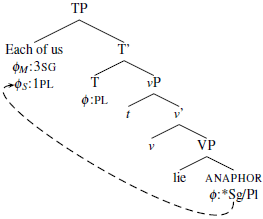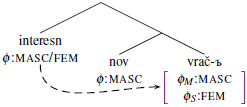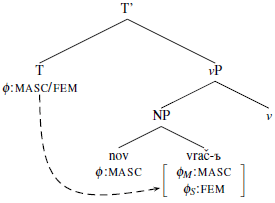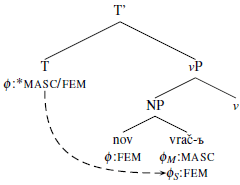1 Introduction
A number of typological and theoretical studies have shown that certain nouns that enter into agreement relationships have the ability to control two distinct agreement values on the elements showing the agreement (Corbett 1979; 2006; 2022; 2023; Wechsler & Zlatić 2000; 2003; Pesetsky 2013; Smith 2015; 2021; Landau 2016b). One value appears to reflect the morphosyntactic features of the noun, while the other agreement value appears to reflect the semantic features of the noun. Take for example, the noun vrač (‘doctor’) in Russian in (1). In (1a) vrač enters into predicate argument agreement with the verb and the agreement on the verb is masculine matching the morphological features of the noun. In (1b), the verb that agrees with vrač shows feminine agreement indicating the referent of the noun is female, hence the agreement morphology appears to reflect the semantic features of the noun.
- (1)
- Russian (Pesetsky 2013: 36)
- a.
- vrač-Ъ
- doctor-nom.sg
- prišël-Ъ
- arrived-m.sg
- ‘A doctor arrived.’
- b.
- vrač-Ъ
- doctor-nom.sg
- prišl-a
- arrived-f.sg
- ‘A doctor arrived.’
One of the more interesting and enlightening aspects of agreement with these so-called ‘hybrid’ nouns occurs when the noun controls agreement on two distinct agreement targets. Using again Russian vrač as an exemplar, observe the data in (2). Like in (1), vrač is undergoing predicate argument agreement with the verb, however, in this set of examples there is also an an adjective that agrees with the noun. As seen in (2a), we see that both the verb and adjective can show masculine agreement. In (2b), we see that a mismatch is possible: the adjective can show masculine agreement and the verb show feminine. (2c) shows that the opposite mismatch where the adjective shows feminine agreement and the verb shows masculine agreement is not possible. Finally, (2d) shows that verb and adjective can both show feminine agreement.
- (2)
- Russian (Pesetsky 2013: 36)
- a.
- Nov-yj
- new-m.nom.sg
- vrač-Ъ
- doctor-nom.sg
- prišël-Ъ
- arrived-m.sg
- ‘A new doctor arrived.’
- b.
- Nov-yj
- new-m.nom.sg
- vrač-Ъ
- doctor-nom.sg
- prišl-a
- arrived-f.sg
- ‘A new doctor arrived.’
- c.
- *Nov-aja
- new-f.nom.sg
- vrač-Ъ
- doctor-nom.sg
- prišël-Ъ
- arrived-m.sg
- ‘A new doctor arrived.’
- d.
- Nov-aja
- new-f.nom.sg
- vrač-Ъ
- doctor-nom.sg
- prišl-a
- arrived-f.sg
- ‘A new doctor arrived.’
As will be shown in the following sections of this paper, this 3/4 agreement pattern is a robust generalization that appears to cut across the features being agreed with as well as the type of target that is showing the agreement. The first part of this paper establishes a novel empirical 3/4 agreement pattern found with Quantified NP constructions (QNPs) in English. I will first demonstrate, following work by Danon (2013), that QNP constructions and hybrid nouns like vrač form a natural class of NPs that display a mismatch between their semantic and morphological feature values. I then build off of previous analyses of agreement with hybrid nouns, to analyze this novel pattern. Two popular assumptions within generative approaches to the 3/4 patterns are: (i) agreement happens as soon as a target is merged into the structure, thus elements that are merged in earlier, agree earlier and (ii) once semantic features enter the structure, access to morphological features for agreement is completely cut off. The data presented here lead to a rethinking of both these assumptions. First, the current proposal allows for some agreement targets, namely bound pronouns and anaphors, to agree later than when they first merge, in line with recent work that treats such agreement as happening outside of the syntax proper. Second, I argue that there is limited access to morphological features even when semantic features are present in the structure. These modifications not only capture the novel pattern but the previous patterns from the literature as well.
This paper hence moves the discussion of agreement and features forward in three significant ways: first, it demonstrates that 3/4 patterns exist outside the narrow realm of hybrid nouns and that NPs with seemingly mismatching features are more common than previously thought. Importantly, the 3/4 patterns shown here do not arise from simple lexical items, but instead arise due to the syntactic context certain NPs find themselves in. Secondly, this paper shows that different agreement targets differ in when they agree: agreement probes on T and adjectives appear to agree as soon as they are merged, but pronominal and anaphor agreement appears to happen later in the derivation. Finally, it shows that once semantic features of an NP have been targeted for an agreement operation subsequent agreement operations must also target the semantic features (cf. Bruening 2020).
1.1 The 3/4 agreement pattern
As mentioned in the introduction, the 3/4 agreement pattern with hybrid nouns is a general pattern that does not seem to be tied to certain types of agreement features or elements that undergo agreement. So the same pattern we witnessed with vrač when it agrees with both an adjective and a verb is replicated when the noun agrees with two adjectives (3). In (3a), lower adjective ‘new’ can show masculine while the higher adjective ‘interesting’ can show feminine agreement, but the opposite mismatch is impossible: the lower adjective cannot show feminine agreement while the higher adjective shows masculine agreement.
- (3)
- Russian (Pesetsky 2013: 38)
- a.
- ?U
- by
- menja
- me
- očen’
- very
- interesn-aja
- interesting-f.nom.sg
- nov-yj
- new-m.nom.sg
- vrač-Ъ
- doctor-nom.sg
- ‘I have a very interesting new (female) doctor.’
- b.
- *U
- by
- menja
- me
- očen’
- very
- interesn-yj
- interesting-m.nom.sg
- nov-aja
- new-f.nom.sg
- vrač-Ъ
- doctor-nom.sg
- ‘I have a very interesting new (female) doctor.’
Moving from gender features to number, we find the same pattern emerges again in Lebanese Arabic number agreement with NPs with numerals over ten. As noted in Ouwayda (2014) and discussed in Pesetsky (2013), numerals over ten must merge with singular nouns as shown in (4a). These nouns can control either singular or plural agreement on the verb (4b).
- (4)
- Lebanese Arabic (Pesetsky 2013: 46)
- a.
- tleetiin
- thirty
- walad
- child.sg
- / *wleed
- / child.pl
- ‘thirty children’
- b.
- tleetiin
- thirty
- walad
- child
- daras-u
- studied-pl
- /
- /
- daras
- studied.sg
- ‘Thirty children studied.’
When an adjective that shows number concord with the noun is added to the structure we find the same pattern we observed with Russian gender agreement as seen in (5). (5a) shows that both agreement targets, the adjective mnazzam and the verb daras, can show singular agreement. (5b) shows that it is possible for the adjective to show singular agreement, but the verb to show plural, while (5c) shows the opposite mismatch is yet again impossible. Finally, (5d) shows that both agreement targets can show plural agreement.
- (5)
- Lebanese Arabic (Pesetsky 2013: 47)
- a.
- tleetiin
- thirty
- walad
- child.sg
- mnazzam
- organized.sg
- daras
- studied.sg
- ‘Thirty organized children studied.’
- b.
- tleetiin
- thirty
- walad
- child.sg
- mnazzam
- organized.sg
- daras-u
- studied-pl
- ‘Thirty organized children studied.’
- c.
- *tleetiin
- thirty
- walad
- child.sg
- mnazzam-iin
- organized-pl
- daras
- studied.sg
- ‘Thirty organized children studied.’
- d.
- tleetiin
- thirty
- walad
- child.sg
- mnazzam-iin
- organized-pl
- daras-u
- studied.pl
- ‘Thirty organized children studied.’
With two agreeing adjectives, we once again see that only one of the two possible mismatches is possible: the lower adjective can show singular agreement and the higher adjective can show plural (6a), but the opposite pattern where the lower adjective shows plural agreement and the higher adjective shows singular agreement is ungrammatical (6b).
- (6)
- Lebanese Arabic (Pesetsky 2013: 47)
- a.
- tleetiin
- thirty
- walad
- child.sg
- kesleen
- lazy.sg
- mnazzam-iin
- organized-pl
- ‘Thirty organized lazy children.’
- b.
- *tleetiin
- thirty
- walad
- child.sg
- kesleen-iin
- lazy-pl
- mnazzam
- organized.sg
- ‘Thirty organized lazy children.’
Staying in the realm of number, Landau (2016b) notes a similar pattern for the Hebrew noun be’alim ‘owners/husbands’. In this case, be’alim is always morphologically plural, however it has the ability to show singular agreement when it refers to a singular entity. Once again, if we have two agreement targets, an adjective and a verb, the 3/4 pattern rears it head. (7a-b) shows that both agreement targets can match in either the singular or plural respectively. (7c) shows that it is impossible for the adjective to show singular agreement and the verb to show plural. The other mismatch as shown in (7d) is possible.
- (7)
- Hebrew (Landau 2016: 984–985)
- a.
- ha-be’al-im
- the-owner-pl
- ha-kodem
- the-previous.sg
- maxar
- sold.3sg
- et
- acc
- ha-makom
- the-place
- lifney
- before
- šana
- year
- ‘The previous owner sold the place a year ago.’
- b.
- ha-be’al-im
- the-owner-pl
- ha-kodm-im
- the-previous-pl
- maxru
- sold.3pl
- et
- acc
- ha-makom
- the-place
- lifney
- before
- šana
- year
- ‘The previous owners sold the place a year ago.’
- c.
- *ha-be’al-im
- the-owner-pl
- ha-kodem
- the-previous.sg
- maxru
- sold.3pl
- et
- acc
- ha-makom
- the-place
- lifney
- before
- šana
- year
- Intended: ‘The previous owner(s) sold the place a year ago.’
- d.
- ?ha-be’al-im
- the-owner-pl
- ha-kodm-im
- the-previous-pl
- maxar
- sold.3sg
- et
- acc
- ha-makom
- the-place
- lifney
- before
- šana
- year
- ‘The previous owner sold the place a year ago.’
Looking at other structures that involve different agreement targets than just an adjective and verb shows the same pattern. As is well known, committee-like nouns can control singular or plural agreement in British (and many other) dialects of English. Smith (2015; 2021) presents a novel type of 3/4 pattern with these nouns. This time instead of looking at a DP-internal element like an adjective that is an agreement target, Smith uses the verb and a bound reflexive pronoun that must match its antecedent in ϕ-features. Despite this difference with the other languages and patterns discussed before, we strikingly find the same pattern, as shown in (8). (8a-b) show that both the verbal agreement and the features of the reflexive can be either be both singular or plural respectively. (8c) shows the one mismatch that is allowed: the verbal agreement can be singular and the reflexive plural. The opposite pattern again is not possible (8d).
- (8)
- British English (Smith 2021: 87, ex. 139)
- a.
- The government has offered itself up for criticism.
- b.
- The government have offered themselves up for criticism.
- c.
- The government has offered themselves/each other up for criticism.
- d.
- *The government have offered itself up for criticism.
The final case study from the literature we will examine looks at the agreement possibility with so-called ‘imposters’ in Icelandic (Wood & Sigurdsson 2014). Imposters are third person DPs that nevertheless refer to the speaker or hearer of an utterance (see Collins & Postal 2012 for extensive discussion of imposters). In Icelandic, the imposter undirritaðan ‘underwritten’ has the ability to control either third person plural agreement or first person plural agreement. It also has the ability to co-refer with a third person plural or a first person plural pronoun. When again these two agreement targets are within the same structure, we see the same 3/4 interaction. Either both can be third person (9b), both can be first person (9c) or the the verb can be third person and pronoun first person (9a). As shown in (9d), the opposite agreement alignment where the verb shows first person agreement and the pronoun is third person is ungrammatical on the co-referent interpretation of the pronoun and undirritaðan.
- (9)
- Icelandic (Wood & Sigurdsson 2014: 219)
- a.
- undirritaðiri
- undersigned.m.pl
- hafa
- have.3.pl
- áður
- before
- sagt
- said
- að
- that
- viði
- we
- munum
- will
- ekki
- not
- styðja
- support
- skattahækkanir
- tax.hikes
- ‘The undersigned have said before they will not support tax hikes.’
- b.
- undirritaðiri
- undersigned.m.pl
- hafa
- have.3.pl
- áður
- before
- sagt
- said
- að
- that
- ϸeiri
- they
- muni
- will
- ekki
- not
- styðja
- support
- skattahækkanir
- tax.hikes
- ‘The undersigned have said before they will not support tax hikes.’
- c.
- undirritaðiri
- undersigned.m.pl
- höfum
- have.1.pl
- áður
- before
- sagt
- said
- að
- that
- viði
- we
- munum
- will
- ekki
- not
- styðja
- support
- skattahækkanir
- tax.hikes
- ‘The undersigned have said before they will not support tax hikes.’
- d.
- *undirritaðiri
- undersigned.m.pl
- höfum
- have.1.pl
- áður
- before
- sagt
- said
- að
- that
- ϸeiri
- they
- muni
- will
- ekki
- not
- styðja
- support
- skattahækkanir
- tax.hikes
- ‘The undersigned have said before they will not support tax hikes.’
Before moving on to the next section that introduces a novel 3/4 pattern involving agreement and binding with quantified NPs in English, let’s summarize the empirical findings laid out here. 3/4 patterns occur across all the ϕ-features: person (Icelandic), number (British English, Hebrew, Lebanese Arabic) and gender (Russian). The pattern also occurs and interacts with a number of different agreement targets: a DP-internal element and predicate argument agreement, two DP-internal modifiers, predicate argument agreement and a locally bound reflexive as well as predicate argument agreement non-local co-referent pronouns. Finally and perhaps most importantly, the direction of the pattern is always the same: it is possible for what appears on the surface to be the closer agreement target to show agreement with morphological features and the further agreement target to show agreement with semantic features. The opposite is never possible. In the analysis section, I show how this pattern follows from the derivational timing of agreement operations and a restriction on the targeting of semantic features.
2 QNPs and hybrid agreement
In this section, I present, to my knowledge, a novel 3/4 agreement patterns involving English Quantified NPs (QNPs). It has been noted in previous literature that quantifier NPs cross-linguistically can agree in at least three different ways: the quantifier can control agreement, the N can appear to control agreement or a default agreement is used (Danon 2013). In English, there has been known variation in agreement in quantifier partitive constructions in the generative literature since at least Kimball & Aissen (1971). Here I will focus my attention on agreement with QNPs with the quantifiers each and none. According to Merriam-Webster’s Concise Dictionary of English Usage (Meriam-Webster’s 2002), each of followed by a plural NP can control both singular agreement or plural agreement on the verb.1 Below are some naturally occurring examples collected by Merriam-Webster’s Concise Dictionary of English Usage. The examples in (10) show singular agreement while the examples in (11) show plural agreement.
- (10)
- a.
- Each of them is a decisive way — Ronald Reagan, Abortion and the Conscience of the Nation, 1984
- b.
- But each of us harbors our own special interests — Tom Lewis, Harper’s Weekly, 26 July 1976
- c.
- And each of them was busy in arranging their particular concerns — Jane Austen Sense and Sensibility, 1811 (in Hodgson 1889)
- (11)
- a.
- Each of the novel’s four strong, articulate, and high energy women are in their mid-thirties — Donna Seaman, Booklist, 1 Apr. 1992
- b.
- … it will be well and decorous that each of us appoint several consulting surgeons — Mark Twain, A Tramp Abroad, 1880
- c.
- … how important each of the possible harms and benefits are — Robert Charles Clark, Corporate Law, 1986
Merriam Webster’s also notes similar optionality concerning agreement when none of is followed by a plural NP though some prescriptivists insist on the singular (As Howard (1980) notes, “A considerable number of the readers of The Times are convinced beyond reason that the pronoun none is singular.”). Again, I give examples cited in the Merriam-Webster’s. The examples in (12) show singular agreement, while the examples in (13) show plural.2
- (12)
- a.
- None of its inhabitants expects to become a millionaire — Bernard Devoto, Holiday, July 1955
- b.
- None of them is happily married today — Judith Krantz, Cosmopolitan, October 1976
- (13)
- a.
- None of these are love letters in the conventional sense — W. H. Auden, New Yorker, 19 Mar. 1955
- b.
- None of the lines are strikingly brilliant — Wolcott Gibbs, New Yorker, 5 Mar. 1955
Looking at other QNPs, in the generative literature, Zanuttini et al. (2012) report that both singular and plural agreement is acceptable when everyone of is followed by a plural NP (14).3 This is shown in (14).
- (14)
- a.
- Everyone of us think(s) that the war in Iraq is wrong.
- b.
- Everyone of you know(s) this article is true. (Zanuttini et al. 2012: 1247)
Collins & Postal (2012) report similar judgements with sentences in (15).
- (15)
- a.
- Every one of us thinks she is talented.
- b.
- Every one of us think we are talented. (Collins & Postal 2012: 156)
Many more examples can be found on online through Google searches. Below in (16), I give a some results from a search on Google Books for the string “everyone of us are.”
- (16)
- a.
- Everyone of us are friendly to Commodity Credit. Everyone of us are trying to protect the integrity of Commodity Credit. — Harold D. Cooley, Processing and distribution of donated food commodities, 1955 (Google Books)
- b.
- Everyone of us are part of a community and participate in some sort of social activity that has our commitment — Earl Saunders Elliot, Introduction to community systems. 1979 (Google Books)
- c.
- Because I hope you know now that everyone of us are nice people — Betty Rose, Warrior of the Last Good Souls on Earth, 2008 (Google Books)
Below in (17) are examples culled from a Google Books search for the string “everyone of us is.”4
- (17)
- a.
- Everyone of us is responsible — CIA Daily report, Foreign Radio Broadcasts, 1967 (Google Books)
- b.
- Everyone of us is entitled to an amount over and above the amount of the cost. The national electrical contractor, 1913 (Google Books)
- c.
- Everyone of is more than just good enough. Shawn Patrick Ryan, Poetry is peace, 2010 (Google Books)
One may worry that what we are dealing with in the case of plural agreement is not grammatical agreement but instead explained by the psycholinguistic phenomena of agreement attraction (Bock & Miller 1991 et seq.). An example of this phenomena is given in (18). Attraction occurs when a NP in a non-agreement controlling position can appear to agree with the verb.
- (18)
- The key to the cabinets are here.
I believe there are four reasons why agreement attraction cannot account for the plural agreement with QNPs: i. plural agreement with QNPs persists even in carefully edited and proofread texts (Copperud 1980) where agreement attraction errors would have been corrected; ii. plural agreement is possible when the NP within the QNP is the first person us (as shown above) while first and second person pronouns seem to resist being attractors in agreement attraction experiments (see den Dikken 2019 and references); iii. one of the findings in the attraction literature is that in order for a element to show strong attraction effects, it must occur in (or be syncretic with) the morphological case that is associated with agreement controlling position (i.e., nominative in English). The effect of case marking is cross-linguistically robust and has been found in English (Nicol & Méndez 2009), Spanish (Méndez 1996), Dutch (Hartsuiker et al. 2001), German (Hartsuiker et al. 2003), and Hindi (Bhatia 2019; to appear). In the examples we have used so far in the present paper, plural agreement is still possible with the non-nominative form us. We also find the same agreement with non-nominative form them as well. A few examples found from COCA (Davies 2008-) and Google searches are given below (see Leclercq & Depraetere 2018 for more in depth corpus work on agreement in QNP constructions).
- (19)
- a.
- Each of them are worth 10. (COCA)
- b.
- None of them are good on the border issue. (COCA)
- c.
- Well, none of them are doing that — Thomas Dunn, Stimulation of Live-stock products, 1919 (Google Books)
- d.
- … when everyone of them are Marvel comics. (COCA)
- e.
- Everyone of them are programs that we attempt to administer as efficiently as possible — Roger H. Jones, SBA legislation and programs, 1982 (Google Books)
Finally, iv. Mazzaggio et al. (2020) experimentally show that Italian agreement with QNPs differs quantitatively from agreement attraction at least for a subset of Italian speakers (see footnote 1) and argue that the agreement demonstrated with QNPs/pseudopartitives must be part of a speaker’s linguistic competence.
Moving on from verbal agreement, like other quantified phrases, quantifier partitives can also bind pronouns, giving rise to the bound variable reading. In the case of a QNP like each/none of us, we find it can bind a third person singular pronoun or a first person plural pronoun (a so-called dependent plural Sauerland 2003; Heim 2008; Sudo 2014) as shown in (20) and (21).5
- (20)
- a.
- Each of usi did heri best.
- b.
- Each of usi did ouri best.
- (21)
- a.
- None of us did heri best.
- b.
- None of us did ouri best.
In a construction where a QNP simultaneously controls agreement and binds a pronoun, we find our familiar 3/4 pattern. It is possible to have the verbal agreement be third person singular and the bound variable pronoun first person plural (22a). It is also possible for the both the agreement and the bound variable pronoun to be third person singular (22b). (22c) shows it is also possible to have the verbal agreement be plural and the bound variable pronoun be first person plural. The last logical possibility where the verbal agreement is plural but pronoun is third person singular is not possible on the bound variable interpretation (22d).
- (22)
- a.
- Each of usi is doing ouri best.
- b.
- Each of usi is doing heri best.
- c.
- Each of usi are doing ouri best.
- d.
- *Each of usi are doing heri best.
- (23)
- a.
- None of usi is doing ouri best.
- b.
- None of usi is doing heri best.
- c.
- None of usi are doing ouri best.
- d.
- *None of usi are doing heri best.
It should be noted that the examples similar to (22a-c) can all be found online searching Google and Google Books. The examples in (24) are naturally occurring examples where each of us controls singular agreement and binds a first person plural pronoun.
- (24)
- a.
- Each of us thinks that our own mistake is the worst — Lucinda Riley, The Seven Sisters, 2014 (Google)
- b.
- … each of us thinks our role is the lead — Chuck Palahniuk, Invisible Monsters, 1999 (Google)
- c.
- Each of us thinks we are the most important person … — Jerry Dubs, Imhotep, 2010 (Google)
Below in (25) are some results of a search for the string “each of us thinks he/his”.
- (25)
- a.
- Each of us thinks his own native tongue superior.
- — https://www.colgate.edu/news/stories/founders-day-convocation-address-george-hudson (Google)
- b.
- Each of us thinks his own country is the best in the world — Gilbert Keith Chesterton, The collected Works of G.K. Chesterton, 1986 (Google Books)
- c.
- Each of us thinks he is immune — William Keim, And Youth was Gone, 2001 (Google Books)
Below in (26) are some results of searches for the string “each of us think we/our”.
- (26)
- a.
- Each of us think we are right — Maya Rinehart, As the Fog Lifts, 2018 (Google Books)
- b.
- Each of us think we know what is possible — Jeffery A. Martin, The complete guide to Reiki, 2011 (Google Books)
- c.
- … the areas where each of us think our federal system could be improved — P.E. Bryden Canada and the end of Empire, 2005 (Google Books)
A search of the string “each of us think he/his” on the other hand only returns 4 results on Google Books. All four are given below in (27). In (27a-b), the example involves Subject-Aux inversion where the auxiliary does is inflected for singular agreement. The examples in (27c-d) are periphrastic causative constructions embedded under the verb make, the verb think does not inflect, hence none of the four examples is a true case of the ungrammatical pattern.
- (27)
- a.
- Why does each of us think he is correct? — Robert W. Burns, The art of staying Happily Married, 1963 (Google Books)
- b.
- What native abilities does each of us think he possesses? — Florence S. Edsall, Success and what it Takes, 1954 (Google Books)
- c.
- It makes each of us think he has more money … —National Council for the Social Studies. Committee on Concepts and Values, 1958 (Google Books)
- d.
- … that’s what made each of us think he was definitely behind it. — Molly Macallen, The index Case, 2022 (Google Books)
The stark contrast between the first three cases and the last case suggests that we are indeed dealing with a categorical distinction between the examples and calls for a grammatical explanation.
In addition to bound pronouns, the 3/4 pattern can also be found with bound reflexive anaphors as shown in (28) and (28).
- (28)
- a.
- Each of usi lies to himselfi.
- b.
- Each of usi lie to ourselvesi.
- c.
- Each of usi lies to ourselvesi.
- d.
- *Each of usi lie to himselfi.
- (29)
- a.
- None of usi lies to himselfi.
- b.
- None of usi lie to ourselvesi.
- c.
- None of usi lies to ourselvesi.
- d.
- *None of usi lie to himselfi.
To summarize this section, I have presented a novel 3/4 agreement pattern involving QNPs. This case involved a QNP controlling verbal agreement while simultaneously binding a pronoun. The next sections of the paper investigate two related questions that arise given this empirical finding: (i) what is the common characteristic of QNPs and hybrid nouns that allows them to both give rise to this distinctive agreement pattern, and (ii) how do we account for the 3/4 pattern found with hybrid nouns and QNPs?
3 Quantifier partitives and hybrid nouns
A question that arises is what do quantifier partitives and hybrid nouns have in common such that they both show this distinctive 3/4 agreement pattern? The answer to this question appears to be that both of these types of DPs constitute a mismatch between the morphological features of the DP and the semantic features of the DP. For instance in the theory of agreement put forth in Wechsler and Zlatić (2000; 2003), they assume that nouns come with both index and concord features. These features typically match one another, but the system does allow for mismatches. Take for example their discussion of deca (‘children’) from Bosnian/Serbian/Croatian (BSC). As shown in (30) deca has the ability to control both feminine singular agreement on the adjective and demonstrative and third person plural neuter agreement on the auxiliary and verb. In the Wechsler and Zlatić system, this is analyzed as the noun having feminine singular concord features, but neuter plural index features (31).
- (30)
- Ta
- that.f.sg
- dobra
- good.f.sg
- deca
- children
- su
- aux.3pl
- došla
- come-pprt.n.pl
- ‘Those good children came.’
- (31)
Landau (2016) entertains a similar analysis for the analysis of Hebrew be’alim. Recall from the previous section that be’alim is morphologically plural but can control singular agreement when it refers to singular referent. Landau proposes that the concord features of the noun are set as plural, but the index features depend on the referential restriction (so singular with a singular referent, and plural with a plural referent), as shown in (32).
- (32)
- Lexical entry for be’alim (HPSG style)
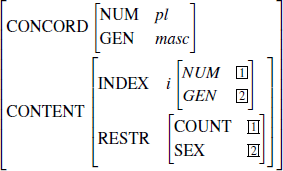
A similar intuition is explored in the works of Smith (2015; 2021) (see also Wurmbrand 2017b). Using more Minimalist terminology, Smith proposes that nouns come with both interpretable features that interface with semantics (similar to index features) and uninterpretable features that interface with the morphology (similar to concord features). In his discussion of the noun committee, he puts forth the idea that the interpretable features of the noun are plural but the uninterpretable features of the noun are singular (33).
- (33)
So it appears that a defining characteristic of hybrid nouns, despite superficial differences in analyses, is that they display a mismatch between the morphological and semantic features. Let’s now turn to QNPs. In a paper on agreement with quantified noun phrases in Hebrew and cross-linguistically, Danon (2013) comes to a remarkably similar conclusion about such DPs that the researchers cited above come to regarding hybrid nouns: certain quantified DPs also exhibit a mismatch between their morphological and semantic features (see also Corbett 2022). Danon’s main empirical domain is quantifier constructions in Hebrew. He notes that for some quantifier constructions it appears that either the quantifier or the apparent noun complement can control agreement on the verb as shown in (34). In (34), it is possible that the verb either shows feminine singular agreement, apparently agreeing with the noun maskoret (‘salary’), or the verb can show masculine plural agreement resulting from agreement with the quantifier 30 axuz-im (30%).
- (34)
- 30
- 30
- axuz-im
- percent-m.pl
- me-ha-maskoret
- of-def-salary.f.sg
- holxim
- goes.m.pl
- / holexet
- / ?goes.f.sg
- le-sxar
- to-rent
- dira
- ‘30% of salary goes to (paying the) rent.’ (Danon 2013: 56).
To account for this behavior, Danon once again relies on the index/concord distinction. He argues that both the noun and the quantifier have both sets of features. In some cases the index feature of the quantifier can be unvalued and instead pick up a value via feature percolation with the index feature of the noun. This is schematized in (35).6
- (35)
- Danon (2013: 77)
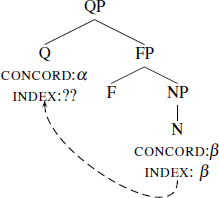
In such cases, assuming that the features of the noun and the Q are distinct, this once again results in a mismatch between the concord and index features that we saw previously for hybrid nouns. Using the example of each of us from the last section, this analysis would lead to the following structure after feature percolation where the concord features of the QNP would be third person singular, but the index features would be first person plural shown in (36).
- (34)
Danon’s analysis of QNP features, hence allows for QNPs and hybrid nouns to form a natural class of DPs that display a mismatch between their index and concord features. The novel observation that QNPs in addition to hybrid nouns display 3/4 agreement patterns lend further support for such a unification. The postulation of the feature mismatches, however, is not enough to account for the 3/4 agreement pattern. Further restrictions on access to these features are needed. Such restrictions are explored in the next section.
4 An account of the 3/4 pattern with QNPs
In this section, I will present an account of the 3/4 agreement pattern with QNPs. The account will incorporate insights regarding the index/concord distinction of QNPs from Danon (2013) discussed in the previous section plus additional insights from previous accounts of 3/4 patterns that I will detail below. The goal of this section is to account for the 3/4 pattern with QNPs using the same mechanisms that underly the pattern with hybrid nouns, giving a unified explanation for the two.
4.1 Previous analyses of 3/4 patterns
In the previous section, it was shown that both hybrid nouns and QNPs can be analyzed as DPs where the semantic features of the DP mismatch from the morphological features of the DP. Many analyses of 3/4 agreement with hybrid nouns have attempted to account for the pattern by proposing that those two types of features enter the syntactic derivation at different times. Take for example Pesetsky (2013)’s analysis of Russian. Recall that in Russian, a noun like vrač can control feminine or masculine agreement on both adjectives and verbs, however if the adjective shows feminine agreement then the verb must also show feminine agreement (shown again in (37)).
- (37)
- a.
- Nov-yj
- new-m.nom.sg
- vrač-Ъ
- doctor-nom.sg
- prišël-Ъ
- arrived-m.sg
- ‘New doctor arrived.’
- b.
- Nov-yj
- new-m.nom.sg
- vrač-Ъ
- doctor-nom.sg
- prišl-a
- arrived-f.sg
- ‘New doctor arrived.’
- c.
- *Nov-aja
- new-f.nom.sg
- vrač-Ъ
- doctor-nom.sg
- prišël-Ъ
- arrived-m.sg
- ‘New doctor arrived.’
- d.
- Nov-aja
- new-f.nom.sg
- vrač-Ъ
- doctor-nom.sg
- prišl-a
- arrived-f.sg
- ‘New doctor arrived.’
To account for this, Pesetsky proposes that there is a feminizing head Ж that can optionally merge into multiple places within the nominal spine as shown in (38). Ж is analyzed as the element that carries the semantic feminine features while the noun itself is the source of the morphological masculine features. Once Ж has entered the structure, all agreeing elements merged later must agree with it due to minimality/locality (Pesetsky 2013: 40).
- (38)
This accounts for the pattern in (37). In (37a), Ж is never merged into the structure and hence both agreeing elements can agree with the head noun and be valued masculine. In (37d), Ж is merged into the structure below the adjective, hence when the adjective probes for an agreement target it will be valued by Ж resulting in feminine agreement, the same happens when T probes, it will be valued by Ж and show feminine agreement. In (37b), the adjective is merged before Ж enters the derivation and probes and agrees with the head noun resulting in masculine agreement. Ж is then merged into the derivation, hence when T probes it agrees with it and is valued feminine. (37c) is ruled out because for the adjective to be valued feminine, Ж must have been merged into the derivation before it. As the adjective is merged within the DP before T is merged into the clausal spine, this entails that Ж must have merged before T. In order for T to show masculine agreement then it must have agreed with the head noun across Ж, however such a derivation would be ruled out due to a locality violation.
Recall that when two agreeing adjectives are present we once again allow for only one of two possible mismatches (example repeated below in (39)).
- (39)
- a.
- ?U
- by
- menja
- me
- očen’
- very
- interesn-aja
- interesting-f.nom.sg
- nov-yj
- new-m.nom.sg
- vrač-Ъ
- doctor-nom.sg
- ‘I have a very interesting new (female) doctor.’
- b.
- *U
- by
- menja
- me
- očen’
- very
- interesn-yj
- interesting-m.nom.sg
- nov-aja
- new-f.nom.sg
- vrač-Ъ
- doctor-nom.sg
- ‘I have a very interesting new (female) doctor.’
The analysis also accounts for the pattern here. In (39a) the adjective nov-yj is merged before Ж and agrees with the noun. Ж is then merged, and acts as the controller of agreement on the adjective interesn-aja. (39b) is once again ruled out because the presence of feminine agreement on the lower adjective nov-aja entails that Ж was merged before it, thus Ж was also merged before interesn-yj and the masculine agreement would once again be ruled out via locality.
As we have just seen, Pesetsky’s analysis is well equipped to account for 3/4 agreement patterns when the agreeing elements are either both internal to the DP (39) or one is internal to the DP and the other external (37). However, as noted by Smith (2021), this type of analysis does not straightforwardly account for 3/4 patterns that arise when both agreeing elements occur outside the DP, as exemplified by the British English pattern with committee nouns. In this pattern (repeated in (40)), the two agreeing elements are both external: a locally bound reflexive pronoun/reciprocal and an auxiliary (i.e. T).
- (40)
- a.
- The government has offered itself up for criticism.
- b.
- The government have offered themselves up for criticism.
- c.
- The government has offered themselves/each other up for criticism.
- d.
- *The government have offered itself up for criticism.
Allowing for multiple merge positions within the DP for the semantic feature does not help here, as regardless of where the feature is merged in the nominal spine it will still be merged prior to being agreed with by both the reflexive and the auxiliary.
Taking the data in (40), as a starting point, Smith proposes a competing analysis of 3/4 agreement patterns. As noted in the previous section, he assumes that all nouns come with two sets of features: interpretable features iFs (similar to index features) and uninterpretable features uFs (similar to concord features).
- (41)
Following many authors (Heinat 2009; Hicks 2009; Kratzer 2009; Bader 2011; Reuland 2011; Antonenko 2012; Wurmbrand 2012; 2017a; Murphy & Meyase 2022; Paparounas & Akkuş 2023), Smith assumes that feature matching between a bound pronoun/reflexive and its antecedent is the result of morphosyntactic agreement. He assumes that the pronoun/anaphor probes its antecedent via the mechanism of Upward/Reverse Agree (Wurmbrand 2012; Zeijlstra 2012; Bjorkman & Zeijlstra 2019). Agreement on T is thought to be the result of the operation agree, as is standardly assumed (Chomsky 2000; 2001). A crucial assumption to Smith’s analysis is that iFs and uFs are not uniformly available throughout the derivation. He restricts access to uFs via the rule in (42).
- (42)
- An active iF cannot be ignored by agreement operations.
He further assumes that iFs can be deactivated throughout the derivation either by starting the derivation deactivated or via undergoing agreement (cf. Chomsky’s (2000) Activation Condition).
With these assumptions, lets examine how Smith’s analysis accounts for the data in (40), starting with (40a). Taking the standard assumption that derivations start bottom up, the anaphor will be the first to probe the subject committee. As shown in (43), the iF: pl feature has begun the derivation deactivated (indicated via strike out), hence the anaphor agrees with the uF: sg feature. Once T is merged into the derivation in (44), it probes committee also resulting in singular agreement.
- (43)
- (44)
Moving on to (40b). In this case, the iF: pl is not deactivated and due to the rule in (42), the anaphor must agree with those features (45). The result of agreement between the anaphor and the iF: pl does not result in the deactivation of the features, however, hence when T is merged and probes it must also agree with iF: pl again due to (42), as shown in (46).
- (45)
- (46)
Now let us turn to (40c). In this case, similar to (45), the derivation begins with the iF: pl being active and the anaphor agreeing with it (47). This time however, the iF: pl is deactivated via the previous agreement operation, hence when T is merged into the structure and probes it must agree with the uF: sg feature.
- (47)
- (48)
Let us finally turn our attention to the impossible mismatch in (40d). In this case, the anaphor shows agreement with the uF: sg. Due to (42), this indicates that the iF: pl feature must have begun the derivation deactivated or else the anaphor would have agreed with it. Since there is no way in this system to reactivate a deactivated feature, this means that iF: pl must be deactivated when T probes as well, so there is no possible derivation in this system that would allow for the anaphor to target the uF: sg feature, while the T targets the iF: pl, hence (40d) is correctly ruled out.
4.2 How the previous theories handle the QNP data
Let us now see if these previous theories can handle the new 3/4 agreement patterns. Just as the case of the British English data in (40), both 3/4 patterns with QNPs involves the two agreement targets occurring outside of the DP, so it appears that a configurational account like Pesetsky (2013) cannot be extended to account for the QNP patterns given here.
The analysis in Smith 2021 can capture the pattern with QNPs. If we assume that QNPs also involve a mismatch between semantic and morphological features, then this analysis can account for the the bound pronoun data with QNP, as it is extremely similar the British English data that Smith built his analysis around. Recall, just as in the British English data, it is possible to have the bound element show semantic/iF agreement and T agreement show morphological/uF agreement (49a). The opposite mismatch is impossible (49b).
- (49)
- a.
- Each of usi is doing ouri best.
- b.
- #Each of us are doing hisi best.
This can be accomplished via parallel derivations laid out in (45)–(48).
While Smith’s analysis does account for the Collective NP data, note that this analysis requires additional assumptions to account for instances when one of the agreement targets occurs inside the DP like the data from Russian or Hebrew. In order to account for these patterns one must assume mandatory late merge of adjectives inside the DP after agreement with T has taken place (Smith 2021: 102). The details of the derivation for the possible mismatch in Russian are given in (50) and (51). Prior to the adjective being counter-cyclically merged, the T probes vrač and agrees with the iF: fem feature (50). In (51), the adjective is counter-cyclically merged and agrees with the noun, but the iF: fem has been deactivated leading to agreement with the uF: masc features. This gives us the possible mismatch where the adjective shows masculine agreement, but the T shows feminine agreement.
- (50)
- (51)
While such accounts of mandatory counter-cyclic merge exist (e.g., Stepanov 2001; Zyman 2021), the availability of such operations is very controversial (Sportiche 2016; 2018). Another potential issue with this line of analysis is that Smith treats hybrid feature mismatches as arising in the lexical entries of the head nouns. As the QNP data shows, ‘hybrids’ can also be created via the syntactic context via the feature percolation mechanism discussed by Danon (2013). In the next section, I will present an analysis of 3/4 patterns with QNPs that also account for the previous data. The innovation of this analysis is that agreement does not always occur in the order that the elements merge, but in certain circumstances, is delayed to later in the derivation. I argue that this move allows us to account for the previous approaches to 3/4 agreement patterns while also capturing the novel pattern with QNPs in English.
4.3 A new analysis
In this section, I will present a new analysis of 3/4 patterns. I assume following the previous analyses, that hybrid nouns and QNPs have a mismatch in morphological (ϕM) and semantic (ϕS) features. What the novel QNP data show us is that there is a difference in the pattern when the target of agreement differs. In order to account for this, I propose that different targets agree at different times. I follow the previous authors who have worked on 3/4 agreement patterns and assume that attributive concord and T agreement happens as soon as the elements are merged into the syntax. Pronouns and anaphors, however behave differently and do not agree with their antecedent when first merged into the syntax. Instead, I argue following a number of recent works, that the mechanism that underlies agreement with pronouns and anaphors happens late in the derivation at the interfaces and not in the syntax proper (Heim 2008; Kratzer 2009; Landau 2016a; Wurmbrand 2017a).
This line of research has used the interface analysis of pronoun/anaphor agreement to account for the fact that features on bound pronouns appear uninterpreted at LF. For instance, take the case of the dependent plural that has been used in previous examples. Although the pronoun is morphologically plural, when it is bound, it is compatible with a singular predicate as in (52a). When it is not bound, however, it can no longer compose with a singular predicate (52b). The PF view of agreement with pronouns accounts for this difference. When the pronoun is bound, its plural features are only present at PF via agreement with its antecedent, in the narrow syntax and at LF, there is no plural feature on the pronoun, hence, it can compose with a singular predicate. When the pronoun is not bound, however, the pronoun is born with plural features and hence those feature exist in the narrow syntax and at LF as well, hence it cannot compose with a singular predicate.
- (52)
- a.
- Each of us thinks we are the richest linguist.
- b.
- #We are the richest linguist.
This has also be used to account for so-called fake indexical readings of first person pronouns. Take for example the case in (53). This example is ambiguous between the two readings in (53a) and (53b). For the reading on (53b), it appears that the first person features of the pronoun are uninterpreted. A prominent account of this reading is to once again have the features of the pronoun only occur at PF, hence invisible for interpretation at LF (Kratzer 1998; Heim 2008; Kratzer 2009; Wurmbrand 2017a).
- (53)
- Only I did my homework.
- a.
- No one else did my homework.
- b.
- No one else did his or her homework.
The fact that we do see 3/4 pattern interactions between what we might call purely syntactic agreement (e.g., T-agreement) and features on bound pronouns/anaphors, however, tells us that these two mechanisms, though distinct, are not completely independent of one another. What I suggest is that agreement operations that happen in the syntax proper can end up restricting the features available later when the structure is sent to the interfaces. If placed in an order, agreement of anaphors and pronouns will occur after agreement of attributive concord and T-agreement, which both happen in the syntax and are tied to the order in which those elements are first merged into the structure (54).7
- (54)
- Order of agreement (across target classes)
- DP-internal concord < T-agreement < pronoun/anaphor agreement
Note now that our ordering of agreement now closely resembles the Agreement Hierarchy of Corbett (1979), repeated below. For Corbett, the Agreement Hierarchy is intended to capture the likelihood of agreement with semantic justification for each agreement target class type; with the likelihood increasing monotonically from left to right. Recent work (e.g., Landau 2016b), has suggested that something like the Agreement Hierarchy governs the distribution of semantic agreement inter-sententially. If this line of thinking is on the right track, this suggests that the agreement hierarchy can be thought of in terms of order agreement operations take place.
- (55)
- Attributive < Predicate < Relative pronoun < Personal pronoun
- (Corbett 1979: 204)
In addition to the assumption about the ordering of agreement operations, I will assume that morphological and semantic features are both in principle potential agreement controllers, but following Bruening (2020), I suggest once semantic features are targeted for an agreement operation, all subsequent agreement operations must also target the semantic features. Here I present this idea as an idea as an order where semantic features are order after morphological features.
- (56)
- Ordering of features
- Morphological < Semantic
I suggest that what gives rise to the 3/4 pattern in agreement with hybrid controllers is there is a constraint that the mappings between the two orders in (55) and (56) be monotonic.8. It is important to note that monotonicity has been shown to have explanatory power outside the realm of agreement and has been used to model a number of morphosyntactic patterns in (Graf 2019; 2020. Graf uses monotonicity to account for Person Case Constraint effects (Bonet 1991 et seq.) and also *ABA effects found in morphology (Bobaljik 2012), to give just two examples; so monotonicity should be viewed as a general constraint that operates over more than just agreement. Here I formalize the constraint on access to semantic and morphological features as the condition in (57).
- (57)
- Constraint on agreement with semantic features (CASF)
- Once semantic features have been accessed for an agreement operation, all other subsequent agreement operations must target the semantic features.
In the next section I will show how the above constraint can derive the novel 3/4 patterns discussed here as well as the ones from the previous literature.9
4.3.1 Derivations
Let us work through derivations of the QNP data to show how the present system accounts for the patterns observed. Following Danon (2013), I assume that the Q heads each and none have a valued third person singular morphological feature (ϕM:3sg), but an unvalued semantic feature. The Q head’s semantic feature is valued by the features of the N head via feature percolation. This is shown in the tree structures in (58) and (59).
- (58)
- (59)
Now consider the cases where one of the agreement targets is an anaphor. Recall from the previous section, it was argued that agreement with bound pronouns/anaphors occurs late in the derivation at the interfaces, after agreement for concord and T agreement. This means that even though the anaphor and the QNP are merged into the structure before T, no agreement happens between the two at this stage of the derivation. T is then merged into the structure. In this derivation, T agrees with the 3sg morphological features of the QNP (60). After the structure has been spelled out to the interfaces, agreement of the anaphor takes place. The anaphor may agree with either the semantic or morphological feature and not violate CASF, as shown in (61).
- (60)
- (61)
This derivation would hence allow for the both the T agreement and the anaphor to show 3sg morphological features or for T to show 3sg agreement and the anaphor to agree with 1pl semantic features. Accounting for the grammaticality of the sentences in (62).
- (62)
- a.
- Each of usi lies to himselfi.
- b.
- Each of usi lies to ourselvesi.
Now let us walk through the other possible derivation. This time T agrees with the 1pl semantic features and surfaces as plural agreement (64). When the derivation is transferred to the interfaces, the anaphor is valued. Due to CASF, it must also target the semantic features (64). Morphological features are not accessible.
- (63)
- (64)
This correctly predicts that when the agreement on T is with the 1pl index features, the features on the anaphor must also be 1pl, hence we correctly capture the judgments in (65).
- (65)
- a.
- Each of usi lie to ourselvesi.
- b.
- *Each of usi lie to himselfi.
Let us now turn our attention to the 3/4 patterns from the previous literature. The British English examples from Smith (2021) follow the same pattern as what has been outlined above for the QNP and anaphors, so the derivations in (60)–(61) and (63)–(64) would also account for that pattern. The pattern we see in Russian and Hebrew would also follow from the same analysis. Recall that in these cases the two targets were either two attributive adjectives or an attributive adjective and T agreement. Let us first work through the cases where there are two attributive adjectives. This example is slightly different from previous ones in that both agreement targets are from the same class (i.e., they are both DP internal adjectives). Recall that when the targets are the same type of element, the order of agreement is determined by the order of merge following both Pesetsky (2013) and Landau (2016b). These data would fit into the analysis as follows: the noun vrač merges into the structure with masculine morphological features and feminine semantic features. The lower of the two adjectives merges with the noun and undergoes agreement with it (66). In (66), the lower adjective agrees with the masculine morphological features, hence when the the higher adjective is merged into the structure, it can agree with either the morphological or semantic features and not violate CASF as shown in (67).
- (66)
- (67)
Now consider the derivation below in (68) and (69). This time the lower adjective has agreed with the feminine semantic features (68), as a result, the higher adjective must also target the semantic features; agreeing with the morphological features would violate CASF, as shown in (69).
- (68)
- (69)
This system then correctly predicts the judgments of the two mismatch cases when we have agreeing attributive adjectives repeated below.
- (70)
- a.
- ?U
- by
- menja
- me
- očen’
- very
- interesn-aja
- interesting-f.nom.sg
- nov-yj
- new-m.nom.sg
- vrač-Ъ
- doctor-nom.sg
- ‘I have a very interesting new (female) doctor.’
- b.
- *U
- by
- menja
- me
- očen’
- very
- interesn-yj
- interesting-m.nom.sg
- nov-aja
- new-f.nom.sg
- vrač-Ъ
- doctor-nom.sg
- ‘I have a very interesting new (female) doctor.’
Finally, let us consider the case where the agreeing targets are an attributive adjective and T. Once again, the adjective would be merged with the noun first and undergo agreement with it. In (71), the adjective agrees with the masculine. That structure is merged into the clause and once T is merged, it can once again target either the semantic or morphological features (72).
- (71)
- (72)
If the adjective targets the semantic feature, as in (73), then, due to CASF, then T must also target the semantic feature (74).
- (73)
- (74)
We have once again accounted for the 3/4 pattern with our new system.
4.4 Summary
To summarize this section, I first reviewed two representative analyses of 3/4 patterns from the previous literature and showed potential issues expanding these analyses to the 3/4 pattern with QNPs presented here. An issue with the previous analyses was that agreement was always tied to the order of merge: targets that merged first, agreed first. I argued that this view is only partially correct. Within a class of agreement targets, merge order does matter, however certain elements can agree later in the derivation than their initial merge timing. Concretely, I argued that pronoun/anaphor agreement occurred late in the derivation as compared to concord agreement and T agreement. This insight coupled with a condition on agreement with semantic features, which makes morphological features features unavailable after a target has been valued by semantic features, covered all of the data including the novel patterns covered in the previous section.10
5 Conclusion
This paper reports the discovery of three novel 3/4 agreement patterns. Empirically, these case studies are interesting because they do not involve hybrid nouns in the intuitive sense, like we have seen with previous 3/4 patterns. Narrowly, the fact that QNPs show such patterns provide novel evidence for theories that treat them similarly to hybrid nouns (e.g., Danon 2013). More broadly the existence of 3/4 patterns with these elements tells us ‘hybridness’ or having apparent feature contradictions is not a lexical idiosyncrasy of some nouns, but rather can come about from the structure of the NP/DP itself and also the syntactic context it finds itself in.
To account for the pattern with QNPs and other hybrid NPs, I argued that concord and T-agreement do agree as soon as the possible in the syntax, but anaphor/pronoun agreement occurs late in the derivation once the structure had been transferred to the interfaces. This proposal was then coupled with a novel constraint on access to semantic features and morphological features. It was argued that once semantic features were accessed for agreement, all subsequent agreement operations must also target semantic (Constraint on Agreement with Semantic Features). As the 3/4 pattern appears to be quite robust and occur in a number of different languages and constructions, it makes the CASF a strong contender for a bona fide linguistic universal. If this is correct, we may ask why this constraint appears to be universal. It has been recently been argued that many (morpho)syntactic universals may be explained via monotoncity (Graf 2019; 2020). For instance, the ban on improper movement, which bans movement from A’-positions (back) to A-positions, can be cast in terms of a monotonicity requirement on the order of operations of syntax (Graf 2020). Similarly, the lack of ABA patterns in many domains of morphosyntax can also captured with monotonicity (Graf 2019). At the right level of abstraction, the CASF also appears to be a similar constraint: once an agreement probe targets the semantic features of a controller, all subsequent agreement probes are banned from agreeing agreeing (back) with the morphological features. If this idea is on the right track, then the constraint on agreement with semantic features is another instantiation of a general property of morphosyntax.
Notes
- There appears to be variation in the ability to control plural agreement among some English speakers (as Merriam-Webster’s writes “both singular and plural are standard, but singular is much more common.”). As a speaker of North American Midwestern English, I find such plural agreement acceptable (and in some cases preferred compared to singular agreement). I have also consulted with four additional speakers of this dialect and they agree that plural agreement is acceptable. Where possible, I try to give naturally occurring examples in the discussion below. These examples were also judged by the speakers consulted. The acceptability of non-attributed examples are based on my judgments and the aforementioned four other speakers. Judgments were uniform unless otherwise noted. It is important to note that similar inter-speaker variation is found in other languages as well. In an experimental study, Mazzaggio et al. (2020) found two populations of Italian speakers: one population appeared to allow for the number of the NP to control plural agreement while another population did not, seemingly mirroring the variation we find in English. [^]
- As the case with other languages (see Wechsler & Zlatić 2003; Danon 2013), not every QNP has the ability to control two distinct agreement types. For example, some of us in (i) can only agree in plural and not singular.
Wechsler & Zlatić (2003) and Danon (2013) suggest that only quantifiers that show ϕ-features themselves can control two distinct agreements. This appears partially true for English, in which QNPs that have the ability to occur with one (e.g., everyone/each one of us) appear to control singular agreement more easily. The example with each, however shows that one is optional when controlling either agreement value. It is possible that in such structures a null one is present, just left unpronounced. This may also be the source of variation noted to me by an anonymous review. They note that in their dialect, singular agreement is degraded with QNPs with none followed by a plural NP. I have also found that singular agreement is less common for QNPs like none of us as compared to each of us when searching for examples online. So it appears that singular agreement with none is subject to variation. We may explain this variation by positing that for some speakers none has ϕ-features, possibly as a remnant of its historical origin not one (Meriam-Webster’s 2002). For these speakers, both singular and plural agreement are possible. For another group of speakers, none does not have any (or has lost its) ϕ-features making it like similar to some above. These speakers only allow for agreement with the number feature of the NP that appears to be the complement of none. [^]
- (i)
- Some of us *is/are happy
- Two of the speakers I consulted reported that plural agreement is not as acceptable in these constructions as the ones with Each/None of NP though not completely unacceptable. The fact that these examples are judged more unacceptable by more speakers may also be reflected in the fact that there are fewer naturally occurring instances online. [^]
- Michael Yoshitaka Erlewine (p.c.) asks whether the use of everyone spelled as one word versus every one spelled as two words affects the search results. On COCA (Davies 2008-), the string “every one of us is” occurs 80 times. while the string “every one of us are” occurs 6 times. The string “everyone of us is” occurs 17 times while the string “everyone of us are” occurs once. The small sample with plural agreement is most likely due to the speaker variation noted in footnote 3. It may be worth noting that in three of the six plural examples found with every one either the quantifier or the DP is coordinated. An example is given below.
I also asked the two speakers mentioned in footnote 3 that judged plural agreement with everyone of us as unacceptable about the above example. They both reported that the example where each and every are coordinated improved the use of plural agreement with the QNP. I will put aside these complex QNPs involving coordination for the remainder of the paper and leave them as a matter for future research. [^]
- (i)
- … but I do know that each and every one of us are the better for having gotten to know Pastor Randy (COCA)
- For speakers that allow for singular they, QNPs can also bind they/them/their as shown in (i).
How to best analyze English singular they is an open question (see Bjorkman 2017; Conrod 2019 for relevant discussion). In the remainder of the paper, I put aside the issue of singular they and leave it as a matter of future research. [^]
- (i)
- Each of usI did theirI best.
- There is another strand of research that treats the different agreement possibilities with quantifier partitives to be the result of structural or labeling ambiguity (Pesetsky 1982; Franks 1994; Manzini & Franco 2019). It is unclear if such approaches can be extended to account for the possibility of mixed agreement when there is more than one agreement target. I leave the possibility of extending these analyses as an area for future research. [^]
- I assume that when the two agreement targets are in the same class (e.g., two attributive adjectives in Russian), that the element merged first, agrees first. Michael Yoshitaka Erlewine (p.c.) asks about constructions where there are two bound anaphors whose ultimate antecedent is a QNP or hybrid noun. He passed along the following examples to me.
- (i)
- a.
- I expect each of the boys to lie to himself about himself.
- b.
- I expect each of the boys to lie to themselves about themselves.
- c.
- *I expect each of the boys to lie to himself about themselves.
In such instances, both anaphors can be singular (ia) or plural (ib), but they cannot mismatch from one another: (ic) and (id). Why might this be? This appears to follow from an independent constraint on feature sharing: namely Rule HPF (Wurmbrand 2017a), which states that features can be shared only between a bound element and its closest structural antecedent. When we combine Rule HPF with the fact that it is possible for DPs inside of PPs to bind out of the PP (Reinhart 1976; Pesetsky 1995; Bruening 2014), as shown in (ii), we can account for the data in (i).- d.
- *I expect each of the boys to lie to themselves about themselves.
In the examples in (i), the anaphor embedded within the about PP must have its features valued by its most local antecedent, i.e., the anaphor in the to PP. It cannot have its features valued by the QNP as that would violate Rule HPF, hence whatever feature the anaphor in the to PP targets must also be shared with the anaphor in the about PP. This correctly rules in (ia) and (ib) and rules out (ic) and (id). [^]- (ii)
- I talked to Maryi about herselfi.
- The formal definition of monotonic mapping is given below.
- (i)
- Given two orders ≤A and ≤B, a function f is monotonic with respect to ≤A and ≤B iff it holds for all objects x and y ordered such that x ≤A y implies f(x) ≤B f(y).
[^]- (ii)
- Given two sets A and B let ≤A ⊆ A × A and ≤B ⊆ B × B. A function f: A → B is monotonic with respect to ≤A and ≤B iff it holds for all x and y in A that x ≤A y implies f(x) ≤B f(y).
- An anonymous reviewer notes that the analysis given here makes many of the same emprical predictions as the analysis in Smith (2021) and wonders if there are any benefits to adopting the current analysis over the one in Smith 2021. One empirical domain where there is a potential benefit is looking at agreement with nominal predicates. Observe the data in (i) first noted in Bejar et al. (2019).
- (i)
- a.
- Each of the three boys is a dancer.
- b.
- *Each of the three boys is dancers. (Bejar et al. 2019: 93, ex. 9)
- c.
- Each of the three boys are dancers.
Like the data discussed in section 2, Bejar et al. (2019) note speaker variation in allowing for plural agreement, but for speakers that do allow it, we see another 3/4 pattern. The speakers I consulted were in agreement with the judgments in (i). If we assume that the morphological features of the QNP are singular while the semantic features are plural, we see that the predicate noun cannot match the semantic features while the verb agrees with the morphological features (ib). This follows from the current analysis since predicate agreement takes place before T-agreement and the CASF would rule out semantic agreement on the predicate followed by morphological agreement on the verb (i.e., T-agreement). Smith’s analysis, I believe, would require some reworking to account for the data in (i), hence I tentatively take the data in (i) as a an argument in favor of the current analysis. I also observed, in Messick 2023, a 3/4 pattern involving predicate agreement and T-agreement in the Dravidian language Telugu that mirrors the data found in (i) (i.e., semantic agreement on the predicate blocks morphological agreement on T, but not vice versa), hence this appears to be a general pattern. [^]- d.
- ?Each of the three boys are a dancer. (Bejar et al. 2019: footnote 6)
- An anonymous reviewer noted that the current analysis may make a wrong prediction regarding bound/“fake” uses of indexical pronouns in languages like German as discussed in Kratzer (2009). Kratzer notes that bound variable readings are blocked in copular constructions when the indexical and verbal agreement are singular. Below is the example noted by the reviewer.
Kratzer gives an analysis where the relative pronoun has two feature specifications: 3sg and 2sg, similar to hybrid nouns and QNPs discussed here, hence we might expect such elements to subject to CASF. It should be noted, however that Wurmbrand (2017a) and Bassi (2021) show that Kratzer’s analysis does not account for the full range of facts. Wurmbrand instead offers a new analysis for data like (i) without recourse to positing multiple features on the relative pronoun, instead using a combination of markedness constraints and Rule HPF. Hence, while the data in (i) appear closely related to the facts discussed in this paper, I believe that they can be analyzed using independent mechanisms. [^]
- (i)
- De
- 2sg
- bist
- be.2sg
- der
- the.masc.sg
- einzige
- only.one
- der
- who.masc.sg
- deinen
- 2sg.poss.acc
- Sohn
- son
- versorg-t
- take.care.of-3sg
- ‘You are the only one who takes care of your son.’ (no bound variable reading)
Acknowledgements
For helpful discussion and feedback that improved this paper, I thank the three anonymous Glossa reviewers and handling editor Michael Yoshitaka Erlewine. Parts of this work were presented at the 2021 LSA Annual Meeting. I thank the abstract reviewers and audience for their comments. I also thank Mark Baker, the members of the Syntactic Theory at Rutgers reading group, and the participants in the Spring 2021 syntax seminar at Rutgers. The usual disclaimers apply.
Competing interests
The author has no competing interests to declare.
References
Antonenko, Andrei. 2012. Feature based binding and phase theory. Stony Brook, NY: Stony Brook University dissertation.
Bader, Monika. 2011. Constraining operations: A phase-based approach account of improper movement and anaphoric binding. Tromsø, Norway: University of Tromsø dissertation.
Bassi, Itai. 2021. Fake features and valuation from context. Cambridge, MA: Massachusetts Institute of Technology dissertation.
Bejar, Susana & Kahnemuyipour, Arsalan & Denniss, Jessica & Yokoyama, Tomohiro. 2019. Number matching in binominal small clauses. In Ache, Maria J & Fábregas, Antonio & Marín, Rafael (eds.), The grammar of copulas across languages, 90–106. Oxford: Oxford University Press. DOI: http://doi.org/10.1093/oso/9780198829850.003.0005
Bhatia, Sakshi. 2019. Computing agreement in a mixed system. Amherst MA: University of Massachusetts dissertation.
Bhatia, Sakshi. to appear. When unmaked case matters: Processing agreement in Hindi. In Bhatia, Sakshi & Chacón, Dustin (eds.), Proceedings of the 7th Formal Approaches to South Asian Linguistics Conference.
Bjorkman, Bronwyn. 2017. Singular they and the syntactic representation of gender in English. Glossa 2(1). 1–13. DOI: http://doi.org/10.5334/gjgl.374
Bjorkman, Bronwyn M. & Zeijlstra, Hedde. 2019. Checking up on (ϕ-)agree. Linguistic Inquiry 50(3). 527–569. DOI: http://doi.org/10.1162/ling_a_00319
Bobaljik, Jonathan David. 2012. Universals in comparative morphology: Suppletion, superlatives and the structure of words. Cambridge, MA: MIT Press. DOI: http://doi.org/10.7551/mitpress/9069.001.0001
Bock, Kathryn & Miller, Carol A. 1991. Broken agreement. Cognitive Psychology 23. 45–93. DOI: http://doi.org/10.1016/0010-0285(91)90003-7
Bonet, Eulàlia. 1991. Morphology after syntax. Cambridge, Massachusetts: Massachusetts Institute of Technology dissertation.
Bruening, Benjamin. 2014. Precede-and-command revisited. Language 90. 342–388. DOI: http://doi.org/10.1353/lan.2015.0045
Bruening, Benjamin. 2020. The head of the nominal is N, not D: N-to-D movement, hybrid agreement, and conventionalized expressions. Glossa 5(1). 1–19. DOI: http://doi.org/10.5334/gjgl.1031
Chomsky, Noam. 2000. Minimalist inquiries: The framework. In Martin, Roger & Michaels, David & Urigareka, Juan (eds.), Step by step; Essays on minimalist syntax in honor of Howard Lasnik, 89–115. Cambridge, Massachusetts: MIT Press.
Chomsky, Noam. 2001. Derivation by phase. In Kenstowicz, Michael (ed.), Ken Hale: A life in language, 1–52. MIT Press.
Collins, Chris & Postal, Paul. 2012. Imposters: A study of pronominal agreement. Cambridge: MIT Press. DOI: http://doi.org/10.7551/mitpress/9780262016889.001.0001
Conrod, Kirby. 2019. Pronouns raising and emerging. Seattle, WA: University of Washington dissertation.
Copperud, Roy H. 1980. American usage and style: The consensus. New York, NY: Van Nostrand Reinhold.
Corbett, Greville G. 1979. The agreement hierarchy. Journal of Linguistics 15. 203–395. DOI: http://doi.org/10.1017/S0022226700016352
Corbett, Greville G. 2006. Agreement. Cambridge: Cambridge University Press.
Corbett, Greville G. 2022. The Agreement Hierarchy revisited: The typology of controllers. Word Structure 15(3). 181–225. DOI: http://doi.org/10.3366/word.2022.0208
Corbett, Greville G. 2023. The agreement hierarchy and (generalized) semantic agreement. Glossa: a journal of general linguistics 8(1). 1–39. DOI: http://doi.org/10.16995/glossa.9164
Danon, Gabi. 2013. Agreement alternations with quantified nominals in Modern Hebrew. Journal of Linguistics 49. 55–92. DOI: http://doi.org/10.1017/S0022226712000333
Davies, Mark. 2008-. The Corpus of Contemporary American English (COCA): 520 million words, 1990–present. Available online at http://corpus.byu.edu/coca/.
den Dikken, Marcel. 2019. The attractions of agreement: Why person is different. Frontiers in psychology 10(978). DOI: http://doi.org/10.3389/fpsyg.2019.00978
Franks, Steven. 1994. Parametric properties of numeral phrases in Slavic. Natural Language and Linguistic Theory 12(4). 597–674. DOI: http://doi.org/10.1007/BF00992929
Graf, Thomas. 2019. Monotonicity as an effective theory of morphosyntactic variation. Journal of Language Modelling 7(2). 3–47. DOI: http://doi.org/10.15398/jlm.v7i2.211
Graf, Thomas. 2020. Monotonicity in syntax. In Deng, Dun & Liu, Fenrong & Liu, Mingming & Westerstähl, Dag (eds.), Monotonicity in logic and language: Second Tsinghua interdisciplinary workshop on logic, language and meaning proceedings, 35–53. Berlin, Germany: Springer. DOI: http://doi.org/10.1007/978-3-662-62843-0_3
Hartsuiker, Robert J. & Méndez, Inés Antón & van Zee, Marije. 2001. Object attraction in subject-verb agreement construction. Journal of Memory and Language 45. 546–572. DOI: http://doi.org/10.1006/jmla.2000.2787
Hartsuiker, Robert J. & Schriefers, Herbert J. & Bock, Kathryn & Kikstra, Gerdien M. 2003. Morphophonological influences on the construction of subject verb agreement. Memory & Cognition 31(8). 1316–1326. DOI: http://doi.org/10.3758/BF03195814
Heim, Irene. 2008. Features on bound pronouns. In Harbour, Daniel & Adger, David & Bejar, Susana (eds.), Phi theory: Phi-features across modules and interfaces, 36–56. Oxford University Press.
Heinat, Fredrik. 2009. Probing phrases, pronouns and binding. In Brucart, José M & Gavarro, Anna & Sola, Jaime (eds.), Merging features, 25–45. Oxford: Oxford University Press. DOI: http://doi.org/10.1093/acprof:oso/9780199553266.003.0002
Hicks, Glyn. 2009. The derivation of anaphoric relations. Amstedam/Philiadelpia: John Benjamins. DOI: http://doi.org/10.1075/la.139
Howard, Philip. 1980. Words fail me. New York: Oxford University Press.
Kimball, John & Aissen, Judith. 1971. I think, you think, he think. Linguistic Inquiry 2(2). 241–246.
Kratzer, Angelika. 1998. More structural analogies between pronouns and tenses. In Stolovitch, D. & Lawson, A. (eds.), Semantics and Linguistic Theory (SALT) 8. 92–110. Ithaca, NY: Cornell Linguistics Club Publications. DOI: http://doi.org/10.3765/salt.v8i0.2808
Kratzer, Angelika. 2009. Making a pronoun: Fake indexicals as windows into the properties of pronouns. Linguistic Inquiry 40(2). 187–237. DOI: http://doi.org/10.1162/ling.2009.40.2.187
Landau, Idan. 2016a. Agreement at PF: An argument from from partial control: An argument from from partial control. Syntax 19(1). 79–109. DOI: http://doi.org/10.1111/synt.12118
Landau, Idan. 2016b. DP-internal semantic agreement: A configurational analysis. Natural Language & Linguistic Theory 34. 975–1020. DOI: http://doi.org/10.1007/s11049-015-9319-3
Leclercq, Benoit & Depraetere, Ilse. 2018. Verbal agreement with partitive noun phrases. Studia Linguistica 72(2). 340–361. DOI: http://doi.org/10.1111/stul.12059
Manzini, Rita M. & Franco, Ludovico. 2019. Agreement of structural obliques parameter: DOM and pseudopartitives. In Irimia, Monica & Pineda, Anna (eds.), Differential objects and datives - A homogeneous class?, vol. 42 (Special Issue of Linguisticae Investigationes 1), 83–102. Amsterdam/Philadelphia: John Benjamins. DOI: http://doi.org/10.1075/li.00030.man
Mazzaggio, Greta & Franco, Ludovico & Manzini, Rita M. 2020. Pseudopartitives vs. agreement attraction: An experimental study. Lingue e linguaggio XIX(2). 159–190. DOI: http://doi.org/10.1418/99002
Méndez, Inés Antón. 1996. Clitics and attraction errors: An experimental study on language production. Tucson, AZ: University of Arizona MA thesis.
Meriam-Webster’s. 2002. Merriam-webster’s concise dictionary of English usage. Springfield, MA: Merriam Webster, Inc.
Messick, Troy. 2023. 3/4 of a monster: On mixed shifty agreement in Telugu. Linguistic Inquiry Just Accepted. DOI: http://doi.org/10.1162/ling_a_00512
Murphy, Andrew & Meyase, Savio. 2022. Licensing and anaphora in Tenyidie. Glossa 7(1). 1–59. DOI: http://doi.org/10.16995/glossa.5740
Nicol, Janet & Méndez, Inés Antón. 2009. The effect of case marking on subject agreement errors in English. In Lewis, W.D. & Karimi, S. & Harley, Heidi & Farrar, S.O. (eds.), Time and again: Theorectical perspectives on formal linguistics in honor of D. Terence Langendoen, 135–150. Amstedam: John Benjamins. DOI: http://doi.org/10.1075/la.135.10nic
Ouwayda, Sarah. 2014. Where number lies: Plural marking, numerals and the collective-distributive distinction. Los Angeles: USC dissertation.
Paparounas, Lefteris & Akku¸s, Faruk. 2023. Anaphora and agreement in the Turkish DP: Delimiting binding-through-Agree. Natural Language and Linguistic Theory. DOI: http://doi.org/10.1007/s11049-023-09583-4
Pesetsky, David. 1982. Paths and categories. Cambridge, MA: Massachusetts Institute of Technology dissertation.
Pesetsky, David. 1995. Zero syntax: Experiencers and cascades. Cambridge, MA: MIT Press.
Pesetsky, David. 2013. Russian case morphology and the syntactic categories. Cambridge, Massachusetts: MIT Press. DOI: http://doi.org/10.7551/mitpress/9780262019729.001.0001
Reinhart, Tanya. 1976. The syntactic domain of anaphora. Cambridge, MA: Massachusetts Institute of Technology dissertation.
Reuland, Eric. 2011. Anaphora and language design. Cambridge, MA: MIT Press. DOI: http://doi.org/10.1093/obo/9780199772810-0050
Sauerland, Uli. 2003. A new semantics for number. In Young, Robert B. & Zhou, Yuping (eds.), Semantics and Linguistic Theory (SALT) 13, 258–275. DOI: http://doi.org/10.3765/salt.v13i0.2898
Smith, Peter. 2015. Feature mismatches: Consequences for syntax, morphology and semantics. Storrs, Connectituct: University of Connecticut dissertation.
Smith, Peter W. 2021. Morphology-semantics mismatches and the nature of grammatical features, vol. 35 (Interface Explorations). Boston/Berlin: De Gruyter. DOI: http://doi.org/10.1515/9781501511127
Sportiche, Dominique. 2016. Neglect. Ms., UCLA.
Sportiche, Dominique. 2018. Somber prospects for Late Merger. Linguistic Inquiry 50(2). 416–424. DOI: http://doi.org/10.1162/ling_a_00306
Stepanov, Arthur. 2001. Late adjunction and minimalist phrase structure. Syntax 4(2). 94–125. DOI: http://doi.org/10.1111/1467-9612.00038
Sudo, Yasutada. 2014. Dependent plural pronouns with skolemized choice functions. Natural Language Semantics 22(3). 265–297. DOI: http://doi.org/10.1007/s11050-014-9107-3
Wechsler, Stepehen & Zlatić, Larisa. 2000. A theory of agreement and its application to Serbo-Croatian. Language 76. 799–832. DOI: http://doi.org/10.2307/417200
Wechsler, Stepehen & Zlatić, Larisa. 2003. The many faces of agreement. Stanford, CA: CSLI Publications.
Wood, Jim & Sigurdsson, Einar Freyr. 2014. Icelandic verbal agreement and pronoun-antecedent relations. In Collins, Chris (ed.), Cross-linguistic studies of imposters and pronominal agreement, 196–237. Oxford University Press. DOI: http://doi.org/10.1093/acprof:oso/9780199336852.003.0009
Wurmbrand, Susi. 2012. Agree(ment): Looking up or looking down? MIT Lecture Handout.
Wurmbrand, Susi. 2017a. Feature sharing or how I value my son. In Halpert, Claire & Kotek, Hadas & van Urk, Coppe (eds.), The Pesky Set: Papers for David Pesetsky, 173–182. MIT Working Papers in Linguistics.
Wurmbrand, Susi. 2017b. Formal and semantic agreement in syntax: A dual feature approach. In Emonds, Joseph & Janebova, Markéta (eds.), Proceedings of the Olomouc Linguistics Colloquium 2016, vol. 5 (Olomouc Modern Language Series), 19–36. Olomouc, Czech Rebuplic.
Zanuttini, Raffaella & Pak, Mjok & Portner, Paul. 2012. A syntactic analysis of interpretive restrictions on imperative, promissive and exhorative subjects. Natural Language and Linguistic Theory 30(4). 1231–1274. DOI: http://doi.org/10.1007/s11049-012-9176-2
Zeijlstra, Hedde. 2012. There is only one way to agree. The Linguistic Review 29(3). 491–539. DOI: http://doi.org/10.1515/tlr-2012-0017
Zyman, Erik. 2021. Phase-constrained obligatory late adjunction. Syntax 25. 84–121. DOI: http://doi.org/10.1111/synt.12226



